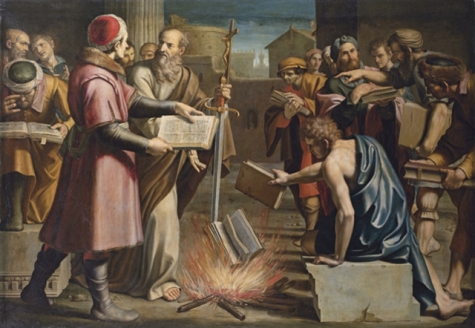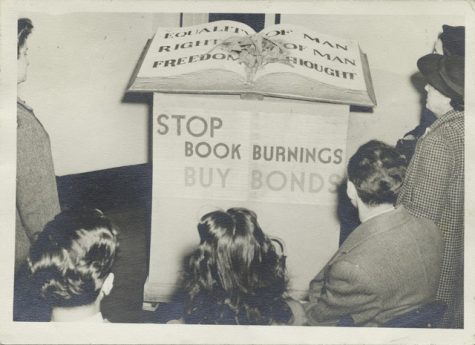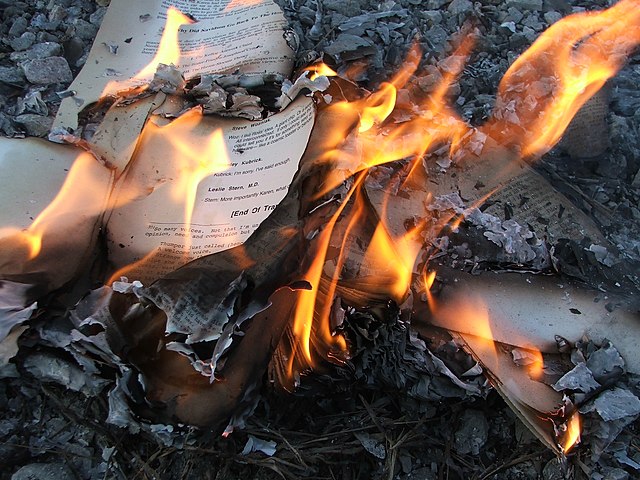The History of Book Banning
Caption: “The book The House of Leaves being burned” Credit: Wikimedia Commons https://creativecommons.org/licenses/by/2.0/
September 27, 2022
What is Book banning?
Book banning, a common form of legal censorship, is a practice of constant flux in the United States. As written in Middle State Tennessee’s First Amendment Encyclopedia, “Book banning…occurs when private individuals, government officials, or organizations remove books from libraries, school reading lists, or bookstore shelves because they object to their content, ideas, or themes.” Book banning is the most widespread form of censorship in the United States. Throughout history, the act has mirrored great trends within society, such as religious persecution and racial suppression.
Historical Examples and Origin of the Practice
According to Edinburgh University’s History, Classics and Archaeology Magazine, book banning can be traced back to the end of the Han dynasty in 221 BCE. This oldest recorded case of book burning in a Chinese library signified a future of political censorship and suppression. Many centuries later, around the time of religious persecution during the Reformations, censorship began to come in increased waves, sprouting fear and stricter control.

In the United States, as stated by the Literary Hub, Stowe’s Uncle Tom’s Cabin was the first book to experience a nationwide ban; all copies of the novel were banned from stores by the Confederacy. This led to a great insurgence in political involvement in literature. As stated in The Atlantic, “this tradition was established in the 19th century to serve the needs of the white, wealthy Protestant producers and consumers who have dominated the field of American children’s literature for much of the past 200 years.”
Another example was the Comstock Law. This law was advocated by Anthony Comstock, who convinced the American Congress to prohibit the mailing and publication of what he considered to be “pornographic” material, meaning: anatomy textbooks, pamphlets about reproduction, The Canterbury Tales, and any works by Oscar Wilde. This practice of censorship became known as comstockery.
From the 1920s onward, American politics noticed a shift in control. Beginning with the achievements in voting rights for women, people began to advocate more for the freedom of reading without limitations and control. This led to one of the most influential literary court cases of American history, The United States v. One Book Called Ulysses. This legal case in 1933 resulted in the overturning of a federal ban of James Joyce’s Ulysses, which had been banned 11 years prior, dismantling the strict control on literature that the nation once held.

A worldwide instance of censorship through literature was during the reign of Nazi leader, Hitler (Edinburgh University’s History, Classics and Archaeology Magazine,). In 1933, in Munich, Germany, Hitler’s regime burned 25,000 books because of their “un-German” qualities. Through this, Hitler attempted to eliminate dissenting views that could challenge his power of authority and control of his nation.
Throughout all these historical examples, it is clear that the original purpose of book-banning stemmed from a fear of change in social order and political voice; it was a way for leaders to control and marginalize the views of minority groups in society.
How it is Being Challenged
In response to a rise in book banning after Reagan’s role as president, the ALA (American Library Association) created Banned Books Week. According to the Literary Hub, the ALA explained, “The point of the event was to get people to understand that these books weren’t pornographic or excessively violent, but simply depicting the real world…and that many were classics of American literature.” Additionally, Director of ABFE (Association of Black Foundation Executives), Chris Finan stated. “Banned Books Week was the first real [American] celebration of the freedom to read.”
Banned Books Week (the last full week of September) fights book banning and tries to discuss the issue of diversity in this practice. In 2016, for example, they explored the racial motivations behind censorship. As reported by The Atlantic, “52% of the books challenged or banned in the last 10 years feature so-called “diverse content” – that is, they explore issues such as race, religion, gender identity, sexual orientation, mental illness, and disability.” Although violence or fantastical elements in novels rarely lead to mass banning, themes surrounding “diverse content” are much more likely to be restricted.
Furthermore, it is more difficult for people of color, minority women, and LGBTQ+ authors to get their works published in an already biased publishing industry.
Book banning can also be harmful to readers of young ages. Rather than protecting young children from explicit themes, banned books typically end up marginalizing these reading experiences. The Atlantic also stated that “Keeping books about certain types of children out of libraries perpetuates a vision of a sheltered American childhood that has rarely existed.”
Our Future
Although book banning is typically seen as a harmful act, it is still an ongoing issue that has deep roots in the history of censorship. As the frequently-banned author, Oscar Wilde once proclaimed, “The books that the world calls immoral are the books that show the world its own shame.”
































